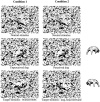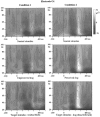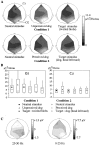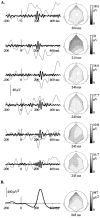Oscillatory gamma-band (30-70 Hz) activity induced by a visual search task in humans
- PMID: 8987794
- PMCID: PMC6573221
- DOI: 10.1523/JNEUROSCI.17-02-00722.1997
Oscillatory gamma-band (30-70 Hz) activity induced by a visual search task in humans
Abstract
The coherent representation of an object in the visual system has been suggested to be achieved by the synchronization in the gamma-band (30-70 Hz) of a distributed neuronal assembly. Here we measure variations of high-frequency activity on the human scalp. The experiment is designed to allow the comparison of two different perceptions of the same picture. In the first condition, an apparently meaningless picture that contained a hidden Dalmatian, a neutral stimulus, and a target stimulus (twirled blobs) are presented. After the subject has been trained to perceive the hidden dog and its mirror image, the second part of the recordings is performed (condition 2). The same neutral stimulus is presented, intermixed with the picture of the dog and its mirror image (target stimulus). Early (95 msec) phase-locked (or stimulus-locked) gamma-band oscillations do not vary with stimulus type but can be subdivided into an anterior component (38 Hz) and a posterior component (35 Hz). Nonphase-locked gamma-band oscillations appear with a latency jitter around 280 msec after stimulus onset and disappear in averaged data. They increase in amplitude in response to both target stimuli. They also globally increase in the second condition compared with the first one. It is suggested that this gamma-band energy increase reflects both bottom-up (binding of elementary features) and top-down (search for the hidden dog) activation of the same neural assembly coding for the Dalmatian. The relationships between high- and low-frequency components of the response are discussed, and a possible functional role of each component is suggested.
Figures








References
-
- Begleiter H, Porjesz B, Wang W. A neurophysiologic correlate of visual short-term memory in humans. Electroencephalogr Clin Neurophysiol. 1993;87:46–53. - PubMed
-
- Bertrand O, Pantev C. Stimulus frequency dependence of the transient oscillatory auditory evoked responses (40 Hz) studied by electric and magnetic recordings in human. In: Pantev C, Elbert T, Lütkenhöner B, editors. Oscillatory event-related brain dynamics. Plenum; New York: 1994. pp. 231–242.
-
- Bertrand O, Tallon-Baudry C, Pernier J. Time frequency analysis of oscillatory γ-band activity: wavelet approach and phase-locking estimation. Biomag96: advances in biomagnetism research Wood CC, et al. 1996. Springer; New York: in press.
-
- Brosch M, Bauer R, Eckhorn R. Synchronous high-frequency oscillations in cat area 18. Eur J Neurosci. 1995;7:86–95. - PubMed
Publication types
MeSH terms
LinkOut - more resources
Full Text Sources
Other Literature Sources
